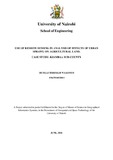| dc.description.abstract | Urban Sprawl is the spreading out of a city and its suburbs over more and more rural land at the periphery of an urban area. This involves the conversion of rural land into built up, developed land over time. Sprawl is characterised by one or more existing patterns of development. Those most frequently mentioned are low-density, leapfrogging, distance to central facilities, dispersion of employment and residential development, and continuous strip development. Urban sprawl on agricultural lands has become a global phenomenon plaguing the entire world especially the developing countries due to increasing population at high rates and consequent depletion of resources.
Remote Sensing techniques are being used in this study to show how the technology can be utilized to solve this problem. Landsat TM (1988), ETM+ (2000) and OLI TIRS (2016) images were used to analyse the effects of urban sprawl on Agricultural land in Kiambaa sub-county. The study is limited to the change in spatial extent of urban areas and agricultural land in general. Supervised classification with maximum likelihood classifier was used to delineate land cover/use in Kiambaa Sub County. Post classification analysis was used for change detection.
The results show the agriculture land in Kiambaa Sub County had reduced with 11.4% from 1988 to 2000 and 14.1% from 2000 to 2016. The urban areas were found to have increased by more than 18 times in 2016 in the spatial extent more than in 1988.From the maps the urban sprawl was characterised by low density, leapfrogging and continuous strip developments. The direction of the sprawl was to the northern part of the sub county where most large and plantation farms are. The sprawl is also likely to flow to the neighbouring sub counties along the roads. The rate of change of agricultural land to urban reduced from 77 hectares per year between 1988-2000 to 72 hectares between 2000-2016.Although the sprawl was not at a high rate as expected, measures need to be taken early to avoid the issue getting out of control. Remote Sensing techniques proved to be an efficient and effective means of mapping and management of urban change.
For sustainability of agricultural activities measures need be taken on management and conservation of the existing land. The government should incorporate use of remote sensing and GIS in its entire sectors to enhance data sharing. County governments should also consider using Remote Sensing and GIS technologies to monitor Land cover/ use changes. | en_US |



